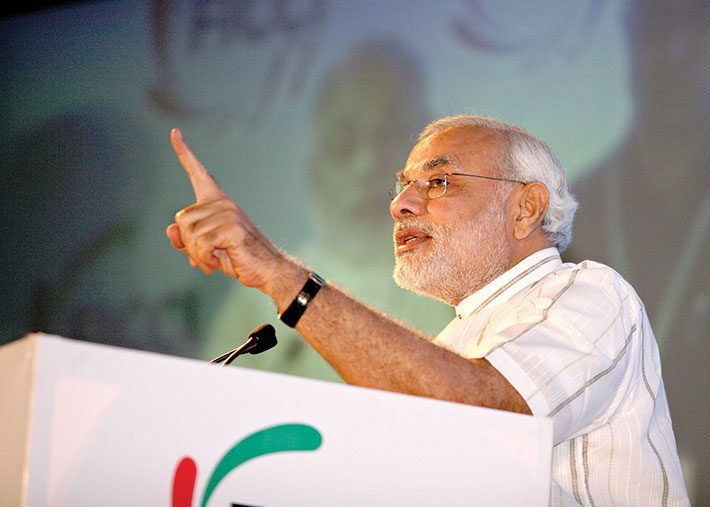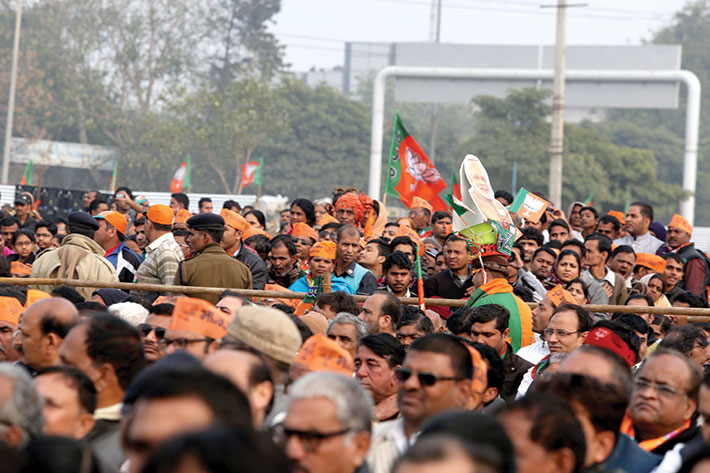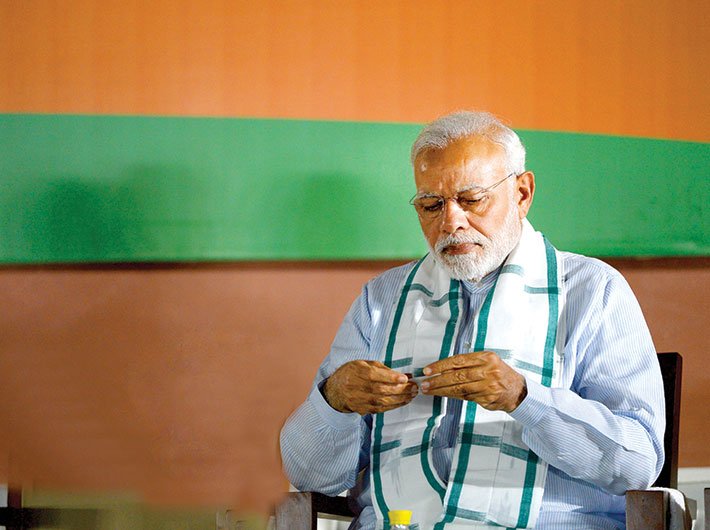Why Modi government faces anxiety instead of confidence on entering the fifth year
When it comes to Narendra Modi and, by extension, his four years at the helm so far, people tend to react sharply, putting objectivity aside. Yet, one objective statement that can be made as his government enters its final year is: Modi as prime minister has proved both his critics and supporters wrong – to an extent. Neither are his achievements anywhere near what his fans had hoped in 2014, nor do the failures come close to his critics’ nightmares.
The promised New India is not so new, achchhe din feel no different from previous days. Yet, the buzz on both sides is that something is changing drastically.
In his trademark way, Modi has made all attempts to keep up the tempo of happenings. One day he is addressing an election rally. The PMs of the past usually didn’t bother about routine elections, whereas Modi, in his hands-on way has taken charge of (and credit or blame for the result of) every state election and every by-election. The next day he is launching yet another acronymed scheme, even if many of them are refurbished versions of long-existing ones. The third day he is off on yet another foreign trip. While his foreign-policy initiatives towards the immediate neighbourhood can be open to criticism, he has largely raised India’s image on the global stage – more so when it comes to the big powers, as he has chosen to build a personal rapport with their leaders. The next day he is heading a video-conference of bureaucrats reviewing the progress of key projects.
In between, he finds time to take to the social media or address the nation informally through radio programmes and setting the social agenda. When the day is free, he coins yet another slogan – the only subject for which Congress president Rahul Gandhi gave him an A+ in his ‘report card’.
Those who see him from close quarters say his enviable energy levels have remained as high as ever as he enters the make-or-break fifth year. That is no mean achievement: far younger leaders – from Rajiv Gandhi to Barack Obama – looked fatigued within four years of being at the top. Amit Shah, BJP president and the first-among-equals when it comes to the PM’s colleagues, is matching him up on the energy quotient. So do most of the key ministers, and the party cadre.
Yet, sloth is building up, in the government and in the party. The government is coming round to admitting that it cannot deliver on all the expectations it triggered with its historic and massive mandate, not within this system. The party is learning to live with uncertainty after an outbreak of exuberance where it went to polls only to win.
This was not the fifth year they had envisioned in 2014. In a way, the Indian voter’s five-year itch is a well known phenomenon, and every PM has faced it. The only exception in recent decades was Manmohan Singh who went on to win the second term. Otherwise, Rajiv Gandhi, PV Narasimha Rao and Atal Bihari Vajpayee have all seen their popularity going down in the fifth year. Blame it on the itch for change. Anti-incumbency, in other words.
But this term entered the psephological lexicon of India only in 1989 – to explain Rajiv’s downfall. Jawaharlal Nehru did not lose a general election, and Indira Gandhi had her ups and downs but for reasons other than plain anti-incumbency. In an idelogy-neutral sense, Modi, over the four years, has been more of a leader in the Nehru-Indira mould than in the Rajiv-Rao-Vajpayee league. Will he be able to seal his membership of the august club by this time next year? There is no doubt that a substantial section of voters continue to admire his leadership, and he is on the top of the political charts with a huge gap between him and the nearest rival. But his popularity is not as high as it used to be, according to a bunch of opinion polls. One of them, ‘Lokniti-CSDS-ABP News Mood of the Nation Survey’, of May 24, has 39 percent respondents in favour of giving the NDA government a second chance, and 47 percent against the idea.
How do we make sense of this boomerang curve of the government’s rapport with people?
There would be many answers; here’s one of them: the hype and hysteria of 2014 with tall promises and unnatural expectations, especially in the spheres of economy and politics.
Economy
The one area where most people had high hopes from Modi is the area where his performance is open to interpretations at best and an outright failure at worst.
In 2014, the Congress-led UPA was a sinking ship as much due to a plethora of scams as due to an economic slump – caused by policy paralysis and marked by lower GDP growth and joblessness. Modi as chief minister had kept the Gujarat economy charged up and at the front of India’s states, and he was expected to do the same for the national economy. It seems now that the skills needed to manage a state economy is only a small subset of the skills needed to manage a national economy: one involves only industrial investments and a fraction of taxes, whereas the other involves the whole macro-economy.

Thus, the GDP growth rate – the arguably bottom line of economic performance – did turn up after Modi took charge, but it hovered below 7.5 percent and showed no inclination to inch towards the promised double digit. Indeed, the politically beneficial but economically controversial decision of demonetisation left the GDP growth rate into a freefall for full five quarters running. On the job creation front, the official number-crunchers have been trying hard to beat the data into submission, and yet ground reality indicates something else: put tellingly into the PM’s comments about job opportunities in pakoda-selling.
As for demonetisation, more than half the people seemed eager in November 2016 to believe in the move’s purported causes and benefits even if they kept changing over the next three months. But when, going by headlines, there is no discernible change in the phenomenon of black money and new currency notes too have spawned fakes, demonetisation does not look to have served any purpose other than winning Uttar Pradesh. After the much-delayed RBI data, showing the return of more than 99 percent cash into the banking system, there has been no official word of explanation. The argument has now shifted to the rise in tax collection figures which unfortunately are not even half as dramatic as the demo decision. Most people have moved on, largely forgetting the pain they went through for what critics termed a bizarre fiat, but those who have lost their livelihoods may have different thoughts.
The shift to goods and services tax (GST) should be one achievement this government would be proud of. Opposed by the BJP when the Congress proposed it – on specific grounds, this was one of those points on the national agenda which the government pushed ahead, risking its rapport with the trade and business class. And it rightly claimed credit for it, with larger-than-life Modi cutouts and nationalist slogans. The initial hiccups in implementation, however, turned the tide. In election-bound Gujarat, the PM’s home state, traders were on warpath, and the PM in his election speeches had to concede that the GST was a decision pushed by all parties, and the centre was only “a 30th part of the GST council”.
Policy paralysis has given way to policy pro-activeness but the number of large-scale projects stalled at the end of the Congress regime has not come down and the investments in them remain in freeze. That, plus the stricter prudential norms introduced by the then RBI governor Raghuram Rajan coupled with the government’s vigilant action, has brought on the great banking crisis. Strictly speaking, it is not the Modi government’s doing: the banking-corporate nexus that turns the business loan into an NPA is a result of the years of bad habits of all stakeholders. But the economy is not capable to absorb this shocker as it is trying to come out of the previous two shocks of demo and GST. Over the next year, despite the government’s best intentions, the banking crisis is going to snowball – and can lead to an avalanche.
The inflation figures, contrary to popular perception, are well under control. So is the fiscal deficit – a praiseworthy achievement for an allegedly populist government. But the middle-class resentment at the rising petrol/diesel prices and their inflationary impact is a challenge for a reformist government that should not take the easy way out. What stings the middle class more than the price is Modi’s and his colleagues’ criticism of the petrol price rise during the previous regime. This is reminiscent of the runaway inflation in dal/pulses – against the background of BJP leaders’ take on the matter five years previously.
The Modi government’s report card on the economic front is not exactly worse than that of the UPA II, but those tall promises – of double-digit growth and strengthening rupee-dollar rate, not to mention Rs 15 lakh in your account by bringing back black money hoarded abroad – have made some in the middle-class feel short-changed.
Politics
Year 2014 was an exception, giving Modi all the aces in his hand. Manmohan Singh had two terms, and a third would have been nearly a statistical impossibility. It helped that the rival claimants were in disarray. The top post was up for grabs, and whoever was the BJP’s prime ministerial candidate stood the best chance. To Modi’s credit, no other candidate – from his party or elsewhere – could have inspired high hopes in people resulting in the rare outright majority for one party.

Over the course of the four years, broadly speaking, Modi’s electoral fortunes have not faltered. Aided by Shah, he has heralded a new age in Indian politics. With their corporate-style strategies, the BJP has turned not only into the self-claimed largest party in the world but also a war machine perpetually in the election mode. They are the first to make use of new poll tactics, using social media and databases. They are like those cricketers who fight for every run and do not give up till the last ball.
The result is that the BJP has won nearly all key state polls (except Delhi and Bihar), made history in the most crucial state (Uttar Pradesh), expanded its footprint to states where it had never dreamed of winning (Assam), and managed to be in power with right alliances some other states (Goa).
Karnataka, with near-majority, should not be seen as an exception. It remains to be seen if it is able to retain power in the three strongholds going to polls this year: Rajasthan, Madhya Pradesh and Chhattisgarh. It will have to combat long anti-incumbency, and it may lose at least one state, if not two. On the whole, Modi the PM has been electorally as successful as Nehru and Indira, if not more, with a pan-Indian appeal.
There is, however, another way of looking at things. All-important Gujarat, for example, proved considerably difficult and was won by merely seven seats above the mid-way mark. Victories in Haryana, Maharashtra, Himachal Pradesh, Uttarakhand, Assam and Tripura can be seen as an anti-incumbency vote or the revolving-door choice. Losses are not small either: Delhi, Bihar, Punjab, Kerala, Tamil Nadu and West Bengal (not to mention states like Goa, where the party’s performance was poor though it managed to be in power in alliance). For a party that came to power at the centre with a stunning majority, wins are on par but the losses stand out. Explanations may differ from state to state, but a pattern to them is that whenever a local force other than the long-term status-quo-ist party (mostly Congress but also CPM) challenges Modi, he does not seem as invincible as he otherwise does. Also, where the regional parties are on a strong wicket, the BJP remains helpless.
Moreover, people vote differently in state elections and national elections. The BJP has lost all but six of the 23 by-elections to the Lok Sabha since 2014 [polling for four more was under way at the time of this writing]. It has lost all six this year (including in UP and Rajasthan) and all five last year. The last by-poll it won was in 2016, around the mid-term point.
What can be the explanation for such mixed electoral fortunes? As with the economy, has it to do with those promises to keep? Modi once was an unapologetic Hindutva leader (in the eyes of his supporters) – a communally divisive figure (going by his critics). But that was in his early years in Gujarat. By 2014, he had fashioned himself into a leader who did not need to resort to majoritarianism to win elections; his ‘development’ track record was sufficient. He arrived to the general election campaign, promising to take everybody along. ‘Sab Ka Saath Sab Ka Vikas’ was an unambiguously inclusive slogan. Considering the Indian constitution alone as the holy book was a praiseworthy statement of intent. There indeed were soft symbols of Hindutva – the call of Ganga Maiya, for one – but they were not altogether threatening.
As prime minister, he has refrained from making any remark that should be a cause of concern for the minorities. In this regard, his track record is better than that of Vajpayee, seculars’ favourite BJP leader. The same, however, cannot be said of a substantial number of his cabinet colleagues, who being his cabinet colleagues do not fall under the definition of the fringe either. And that’s considering only words. As for deeds, there have been acts of commissions and omissions that have broadened the historical divides. As Hindutva foot-soldiers resorted to crimes and misdemeanours under the garb of substance-free symbolic Gauraksha and similar planks, the leadership chose not to restrain them. The result is the perception of rising intolerance, to the extent that the tricolour has been spotted on the body of a lynching accused in Dadri and in the protest to save a rape accused in Kathua.
The failures need to be equally blamed on the opposition, especially the Congress which has shown no signs of learning from its worst defeat and the leftists who are oblivious to the question of their relevance. The two do not get as much credit as they deserve for Modi’s invincibility and popularity.
It may be survival instinct that has united the opposition leaders against Modi, but it is the deepening of such social divisions – not only of religion and community but also of caste – that is making the new opposition different from its 2014 version. After the SP and the BSP united against the BJP, analysts have looked at the UP results and said the duo would have easily defeated Modi in the state. In 2019, they are likely to be together.
[email protected]
(The story appears in the June 15, 2018 issue)



